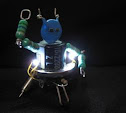
the Python script: (compatible with my Portable Eric 4 Python IDE (v2))
#################################
# USB-based oscillpscope (beta)
# using pyUSB and PyQt/PyQwt
#################################
import sys, usb
from PyQt4.QtCore import *
from PyQt4.QtGui import *
from PyQt4.Qwt5 import *
from PyQt4.Qwt5.anynumpy import *
class UsbPic:
def __init__(self, vendor_id, product_id):
busses = usb.busses() # enumerate busses
self.handle = None
for bus in busses:
devices = bus.devices
for dev in devices:
if dev.idVendor==vendor_id and dev.idProduct==product_id: # device matches
self.dev = dev
self.conf = self.dev.configurations[0]
self.intf = self.conf.interfaces[0][0]
self.endpoints = []
for endpoint in self.intf.endpoints:
self.endpoints.append(endpoint)
return
def open(self):
if self.handle:
self.handle = None
try:
self.handle = self.dev.open()
self.handle.detachKernelDriver(0)
self.handle.detachKernelDriver(1)
self.handle.setConfiguration(self.conf)
self.handle.claimInterface(self.intf)
self.handle.setAltInterface(self.intf)
return True
except:
return False
def write(self, ep, buff, timeout = 100):
try:
return self.handle.interruptWrite(ep, buff, timeout) #return bytes written
except:
return 0
def read(self, ep, size, timeout = 100):
try:
return self.handle.interruptRead(ep, size, timeout) # return data read
except:
return []
def getDeviceName(self):
return self.handle.getString(2, 40)
class AmplitudevsTime(QwtPlot):
def __init__(self):
QwtPlot.__init__(self)
self.setTitle("<font size=1 color=darkblue>Potentiometer Position ( 8-bit ADC value )</font>")
self.setCanvasBackground(Qt.black)
#grid
grid = QwtPlotGrid()
#grid.enableXMin(True)
#grid.enableYMin(True)
grid.setMajPen(QPen(Qt.darkGreen, 0, Qt.DotLine))
grid.setMinPen(QPen(Qt.darkGreen, 0 , Qt.DotLine))
grid.attach(self)
# x-axis
self.setAxisTitle(QwtPlot.xBottom, "<font size=1 color=darkred>time (seconds)</font>")
self.timerange = arange(0.0, 60, 0.2) #60 seconds, 200 ms interval
self.amplitudes = zeros(len(self.timerange), Float)
# curve
self.amplitude_plot = QwtPlotCurve('Amplitude')
self.setAxisScale(QwtPlot.yLeft, 0, 255) #amplitude range : 0 to 255
self.setAxisScale(QwtPlot.xBottom, 0, 60) #time range: 0 to 60 seconds
self.amplitude_plot.setPen(QPen(Qt.yellow))
self.amplitude_plot.attach(self)
def updatePlot(self, new_value=0):
# shift amplitude array left and assign new value to z[n-1].
self.amplitudes = concatenate((self.amplitudes[1:], self.amplitudes[:1]), 1)
self.amplitudes[-1] = new_value
self.amplitude_plot.setData(self.timerange, self.amplitudes)
self.replot()
class MyForm(QDialog):
def __init__(self, parent = None):
super(MyForm, self).__init__(parent)
self.setWindowTitle("USB-based Oscilloscope (Beta) - pYUSb + PIC18F2550")
self.setMinimumSize(560, 300)
# create widgets/controls
self.connect_btn = QPushButton('Connect')
self.toggle1_btn = QPushButton('Toggle LED1')
self.toggle2_btn = QPushButton('Toggle LED2')
self.status_label = QLabel('press "Connect" button')
self.update_timer = QTimer()
self.display = AmplitudevsTime()
layout = QGridLayout()
layout.addWidget(self.display, 0, 0, 10, 15)
layout.addWidget(self.toggle1_btn, 2, 15)
layout.addWidget(self.toggle2_btn, 2, 16)
layout.addWidget(self.connect_btn, 7, 15)
layout.addWidget(self.status_label, 4, 15, 2, 2)
self.setLayout(layout)
# widgets initial condition
self.toggle1_btn.setEnabled(False)
self.toggle2_btn.setEnabled(False)
# signals
self.connect(self.connect_btn, SIGNAL("clicked()"), self.DeviceConnect)
self.connect(self.toggle1_btn, SIGNAL("clicked()"), self.toggleLED1)
self.connect(self.toggle2_btn, SIGNAL("clicked()"), self.toggleLED2)
self.connect(self.update_timer, SIGNAL("timeout()"), self.updateDisplay)
def DeviceConnect(self):
self.device = UsbPic(0x04d8, 0x0204) # Microchip Vendor ID and Product ID
if self.device.open():
self.toggle1_btn.setEnabled(True)
self.toggle2_btn.setEnabled(True)
self.update_timer.start(200) # update every 200ms
self.status_label.setText('Connected to:\n %s' %self.device.getDeviceName())
else:
self.toggle1_btn.setEnabled(False)
self.toggle2_btn.setEnabled(False)
self.update_timer.stop()
self.status_label.setText('Warning:\n No Device Found!')
def toggleLED1(self):
self.device.write(1, [0x80], 1000)
def toggleLED2(self):
self.device.write(1, [0x82], 1000)
def updateDisplay(self):
self.device.write(1, [0x81])
byteread = self.device.read(0x81, 64)
if len(byteread)>1:
self.display.updatePlot(byteread[1])
if __name__ == "__main__":
app = QApplication(sys.argv)
form = MyForm()
form.show()
sys.exit(app.exec_())
Right now, my problem is on the 18F2550 side. I still don't know how to use both the USB and ADC interrupts together. My first modification on PIC's firmware was no success. When I enabled the ADC interrupt routine, the whole program response slows down. I still have to read properly the datasheet(plus application notes), and ask for help of the 'masters'. What I'm currently doing on the code is reading a single byte of ADC value every 200ms (very slow!). From what I've understand, the PIC can (it should) send 64 bytes for every USB interrupt read request. I don't know how fast it is, but it will surely improve the PIC18F USB-based oscilloscope.



never thought i would feel this happy, thank you for this new information.
ReplyDeletesolat sunat witir
cara buat video
Cara memulakan perniagaan kecil